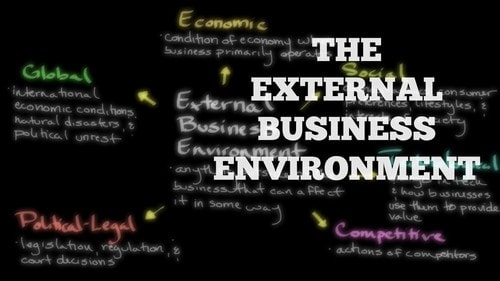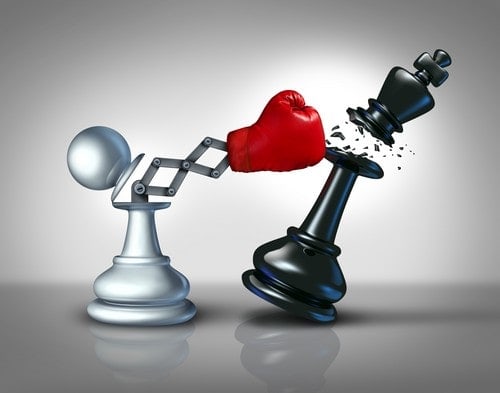Business environment refers to any kind of internal or external forces which have an effect on the functioning of the business in a positive or negative way. The environment may affect the business to the extent that there may be a need to modify or revamp the entire business.
The environment poses threats challenges as well as gives opportunities and chance to grow to the business. All of this comes with an enriched learning experience for everyone associated with it. For the purpose of classification, there are different types of business environment.
Table of Contents
Following are Two types of business environment:
Primarily the types of business environment are classified under two categories;
- Internal Business Environment
- External Business environment
Internal Business Environment
As the name suggests, the internal business environment includes physical assets, human, financial and marketing resources, technological supports, the management etc. Financial resources represent the financial capabilities of the organization, while physical resources are an indicator of physical assets which include machinery, production plant, and buildings etc which convert the input into output.
Human resources are a very crucial factor in the internal business environment. The managerial decisions are taken by human resources while technological resources represent the technical knowledge which is used in the manufacturing of goods and services. Internal environment consists of the factors which are controllable and which can be changed according to the requirements of the external environment. There’s been a drastic change in the internal environment in the last decade or so. The contemporary work environment does not help the employees to be more productive and the Internet is your organization that suffers.
That is the reason why organizations have started to adopt a more flexible way of working by making necessary changes in the internal environment. Write from given liberty of wearing informal clothes at the workplace to having Gyms and even work from home facilities, the internal environment has become more employee friendly rather than work friendly because organizations have realized that the true potential lies in the human factor. Google is the benchmark of one of the best companies providing the best internal environment to their employees.
External Environment :
The external environment is relatively watched compared to the internal business environment. It is composed of various organizations institutions and other forces which operate beyond the control of the organization. It is further classified into external micro and external macro environment.
External Micro Business Environment: Microbusiness forces have a major impact on the operations of a business. For example, suppliers have a huge impact on the pricing of the products. Also, a competitive firm will start a price war in an industry which is relatively small but if the rival firm is a big one then the competitive firm will hesitate to initiate the price war. Following are important factors of micro external environment:
A) Suppliers of Inputs :
This is a very important part of the external type of business environment which include supplier of its inputs such as components and raw materials. For the smooth functioning of an organization, it is very essential that the inputs such as raw material should be regular. If the supply of the same is not certain then it is recommended that organization should have a large stock of raw materials so that the process is continued uninterrupted. This will result in an increase in the cost of production and a reduction in profit margin or the customers will have to bear the increased price.
Many of the organizations have adapted to set up a phone production plant for procuring of raw materials. Similarly, energy is also an important input in the business of manufacturing. Many industries have adapted to set up their own power generating plants so as to ensure an uninterrupted supply of electricity for their businesses. However small organizations cannot adopt the strategies and have to depend on external sources for the supply of these inputs.
It is not recommended to depend on a single supplier for any of these inputs because of there is any destruction due to workers strike or lockout or similar things on the supplier’s end, then it will affect the production work of the organization negatively. Hence to reduce the risk and uncertainty it is advised that organizations go ahead with multiple suppliers.
B) Customers :
The entity who buys products or uses services of the organization in exchange for money is called a customer. They form an important part of the external environment and of the business because all of the profits depend on customers.
It is necessary that your organization focuses on sales and to cater the customers via customer service which are two important factors for customer satisfaction. An organization may have different kinds of customers. For example, Audi cars we have individual customers, government, companies, institutions etc. Although all of them are separate entities and the deals with them will be on different levels all of them can be classified as customers for the organization.
The organization will always be in competition with rival firms to get more customers thereby to increase the market share of the organization. It does so by increasing the demand in the market by spending on advertisements and promotions. The usual strategy of most of the organization is to get new customers and retain the old ones.
A part of retaining customers is giving more customer satisfaction. Recently customer satisfaction has become of Paramount importance because of the fact that customers are provided with multiple options for buying the products. If a customer is not satisfied with a certain product or service we can always opt for competitive one it was not the case about half a century ago.
C) Marketing Intermediaries :
Marketing intermediaries play a very important role in distributing and sometimes of selling the products to the final buyers. These include merchants and agents which are distribution firms, retailers, wholesalers etc. They are responsible for transporting of goods from the production site to the destination and to the final customer.
Organizations can take help of different agencies such as market research consultancies, advertising agencies, management consultancies, which help the organizations in promoting targeting and selling the products to the correct markets. Therefore marketing is considered an important link between customers and organizations.
D) Competition :
Absolute Monopoly is a concept which is long gone from the market. Competition is prevalent and seen in every sector of business. Organizations compete with each other and not only to get customers but also a lot of other aspects. Although the majority competition is on price there is a non-price competition in advertising sponsoring in the event or even and recruiting the best talents in the market.
A well known famous example of recruiting the best talent is that of Steve Jobs recruiting John Sculley an executive from Pepsi. To get John onboard Steve Jobs sad the famous line, ‘Do you want to sell sugar water for the rest of your life or do you want to come with me and change the world?’ Google is known to pay millions of dollars to get the best of the talent.
Competition can also be seen in terms of CSR activities. Following the footsteps of Coca-Cola Pepsi has started save water campaign which estimates about 30 million tones of water will be saved because of manufacturing process changes of Pepsi.
Intense competition can also be seen in the procurement of raw materials from the suppliers. Since the sources of raw materials are limited businesses often compete with each other. Competition is not only limited itself to your competitors but the global competition is also on the rise. With globalization, global competition and price wars not only disturb the economy is but also customers. For example, an organization in the United States will compete with an organization from Japan or China or India.
E) Public :
These are a very important part of external microenvironment in the type of business environment. Any group which has interest or impact on the ability of the organization to achieve its objective is termed as public.
Associations of citizens, local groups, consumer protection organizations, environmentalists, Women Associations, Media, groups of youth are few of the important examples of the public which have an impact on the organization. Environmentalists have a huge impact on the working of the organizations which pollute the environment. Many citizen groups actively campaign against cigarette manufacturers and alcohol manufacturers for manufacturing in a false way to lure more and more youth. Hence public as an important aspect which can make or break the organization.
2) External Macro Business Environment :
The microenvironment factors are the environmental forces which are faced by the organization and determine the opportunities to exploit in order to promote its business and also present a threat so that it can put restrictions on the expansion of Business and its related activities.
The macro environment has both negative and positive aspects to it. A very crucial part of macro environmental forces is that they cannot be controlled by the management of the organization and because of its own controllability the firm or the organization has to adjust itself in order to adapt to these external macro forces.
It is further classified into different types of business environment which will be discussed as follows:
A) Economic Environment :
The economy that exists around the industry which is common for the business, as well as its competition, is termed as economic environment. There can be different phases of the economy like growth or decline which can impact the working of the organization. The economic environment is largely affected by the government of the respective country and it may present opportunities and threats are restrictions to the industries.
The framework within which the businesses have to work is provided by the economic system. Largely there are two factors which affect the economic system that is the public sector and the private sector. While Public sector is largely government influenced, Private sector is with private firms and investors. Foreign exchange also forms an important part of the economic environment. The fluctuations in the currency on a global scale can affect the economies of different countries drastically. Also, import-export forms another important aspect of the economic environment. For a positive economic environment, it is desired that the exports of a country should be more than the imports.
B) Social and Cultural Business Environment :
While we saw that Customers and Public affect Microenvironment of the organization, their social and Cultural aspects affect the macro environment. This is true especially in case of multinational firms which bring the culture from their own country in the countries of businesses. The organizations have to understand the cultural aspects and social aspects of the country that the business is being done in.
The products of businesses can have a large impact on society. For example, there are cultural dimensions in Asian countries which prevent them from eating certain foods. Care should be taken by the organization was introducing the food options and they should be customized for the customers in the local areas. For example, McDonald’s has customized their menu for Asian markets because of the religious factors by the communities from the Middle East and Asian countries.
Beef is not accepted in the Asian market and countries like India while pork is not accepted in Middle Eastern countries. Hence McDonald’s and KFC and other food chains had to come up with customized menu options respecting the local and cultural barriers. New concept code social responsiveness has been developed by management science.
The ability of the organizations to get its businesses to the social environment in a way that is mutually beneficial to both society and the organization is called social responsiveness. Social responsibility and social responsiveness are a part of Business ethics. It is essential that every business does its mode of operation within ethical limits.
C) Political and Legal Environment :
Each and every business is closely related to the government in the operating country. The political influence of the government affects business to a large scale in a positive or negative way. It is very important to take the political and legal nature into consideration for operating any business. Businesses come in constant clashes with these two and get affected from time to time.
For example, Facebook has always come under the constant radar over its data leaks in the US and abroad. Going to the data leaks, many countries have banned Facebook in their countries. A similar threat is eminent with Google which is why Google search engine is banned in China. Because of social media rumors spread what is here and fast the news and that is why curbing social media has become an important aspect in every country.
That is the reason why new and new laws are emerging to control social media and make it safer and secure for the people. On the other hand, there are policies which affect companies and businesses in a positive way.
For example in 2017, there was a demonetization in India as a part of the war against black money. Due to the immediate and overnight Ban of currency, digital currency grew in a proliferative way. Thus the political and legal aspect proved to be a boon for many businesses.
D) Technological Environment :
Technology is evolving by leaps and bounds and is it is essential for the businesses to keep in touch with the ever growing technology to update them and be in the race. New technology is now being used for the production of goods and services.
Use of machines to standardize processes is now the regular way of doing things because it reduces the cost as well as enhances productivity. The use of latest technology also gives the organization a competitive advantage over the competition due to which it gets a better market share. Has globalization has increased the organizations now compete with each other in international markets for the sale of their products which is why they have to standardize themselves according to the international standards.
Right from manufacturing after sales, many aspects of the organization depend on technology which is why Technology plays a vital role in conducting the business. While in some industries technological advancement is helpful not every industry will agree with the same. For example, sales are an aspect where technological aid is necessary for Technology cannot entirely replace it.
E) Demographic environment :
As the name suggests demography includes the growth of the population and the size of the population along with life expectancy of the people, the distribution of population among rural and urban settings and technological skills and education levels of the people.
These factors have an important impact on the functioning of organizations since many workers are recruited from external sources; demographic factors are considered an important aspect. The skills of the workers of the organization affect and determine how well the organization can achieve its targets.
The businesses we have to adjust the requirements so as to adapt themselves to the requirements of the labor forces. For example, having a labor welfare programme or child care services for their employees. The demographic environment impacts the supply and demand equality in any business.
The organizations get their labor force from external sources. The technical education skills of employees are important for the functioning of the organization which is where the demographic environment comes into the picture. Demography also comes into the picture when foreign investors look to make the investment. For example, India is considered as one of the largest English speaking countries in the world which is to its advantage and that is why the global economies like the US and UK prefer to outsource work to India other than China which is cheaper but English is not a language of choice over there.
The growth rate of the population age and even the composition of the population determine the demand of the goods and services for a particular population. When the population of a country is growing its child population will be on the higher side why the stable population will have a geriatric population in higher side. This means that organization will have to plan their offerings accordingly.
For example, while China is the most populous country in the world, the growth rate of population in India is the highest in the world. On the other hand, in countries like Japan and Norway, the population is growing negatively. Which means that requirement for products related to infants and childcare will be on higher demand in India well mortuaries and geriatric requirements will be higher in Japan or Norway?
F) Natural Environment :
The natural environment is the ultimate external environment which affects the business. Availability of natural resources and the setting up of business depends largely on the natural environment. It is desirable that the natural environment is to be kept relatively unharmed.
Natural resources include geographical and economic resources like oil reserves, mineral reserves, water and forest resources, weather and climate, conditions, availability and facilities of Port, connectivity to other countries and development of the surrounding areas. For example availability of minerals influences certain industries in that area.
An area with high mineral content will always attract raw material manufacturing companies steel producing in industries. On the other hand of forest resources are abundant it with attracting pharmaceutical industries and their plants, an area where agricultural resources on the higher side, it attracts food industries. Besides this weather and climate conditions are also an important aspect for the business.
It will not matter how cheap is the land if there are no resources surrounding it. For example, most of the Middle East is desert and no industry can be set up over there which is why even though the land rates a relatively cheap no industry is set up over there. On the other hand, Africa is abundant in forest reserves but due to political factors industries refrain from setting up over there.
Liked this post? Check out the complete series on Business









Wow!
I’ve got all what I needed to know here.
Everything is in details.
This article was next to impossible to read. Poorly written and no references. Yikes.
While the article contained relevant and important information, it was difficult to read as there were a lot of grammatical errors. There were also no cited research or expert input to corroborate any of the information or assertions provided. These are not all original ideas, so others intellectual property should have been cited.